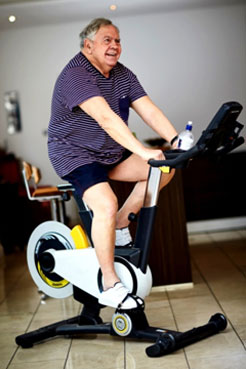In case you didn't know: Exercise is really beneficial for people with type 2 diabetes. It assists in controlling blood sugar levels, boosting energy levels, making your heart healthier, and promoting emotional well-being as well. Barring the medical complications, most of the people with diabetes can and should exercise for effective control of diabetes and for improving overall health and well-being.
Diabetes is basically a lifestyle-related disorder.
It is a disease in which a body can't properly control the amount of blood glucose, and either doesn't produce sufficient amount of insulin or does not utilize it properly. It is extremely crucial for a diabetic patient to maintain blood sugar levels and to work-out regularly.
If you are a diabetic, exercising can help you burn fat, increase muscle mass, strengthen balance, decrease stress — and may gradually reduce your need for insulin as well.
Unsure of where to start? Here are a few exercise tips that can help you achieve your fitness goals efficiently.

1. Walking comes first!
All you need is a perfect pair of shoes and you're ready to go. Walking is probably one of the most advised activities for those suffering from type 2 diabetes. Brisk walking is done at a pace that increases the heart rate is an aerobic exercise, and research shows amazing effects when diabetics engage in aerobic activities at least three days every week for a total of 150 minutes.
Take help of a treadmill - A treadmill can be of great help for brisk walking or running indoors. Treadmill exercising benefits in diabetes control by improving insulin sensitivity of muscles for nearly 24 to 48 hours following work-out.
As it allows a person to walk at home, it is a super-easy way of exercising. It takes up a small space for storage and can be easily moved around. It lets an individual set his own speed and displays the reading on the monitor. The belt system helps to run or walk in the right direction.

2. Let's lift up some weights
Weight training strengthens muscle mass, crucial for those suffering from type 2 diabetes. As part of your diabetic management plan, schedule your resistance exercise or weight training work-out ideally thrice every week, not forgetting a rest day in between.
Every session must include 5 to 10 types of lifting involving the major muscle groups. For maximum strength gains, work your way up to doing three to four sets of an exercise, with every set comprising of 10 to 15 repetitions.
If you wish to include weightlifting into your weekly work-out schedule, you can use weight machines, free weights, or heavy household objects, such as canned goods or water bottles. Liked the idea?
To learn how to lift weights with utmost safety and efficiency, consider joining a weight lifting class or taking proper guidance of a professional fitness expert.
 3. Stationary Exercise Bikes – for some magical effects
3. Stationary Exercise Bikes – for some magical effects
Bicycling is also an effective form of aerobic exercise, one that strengthens your heart and helps your lungs function better.
A stationary bike is best suited for diabetics because you can use it at home, no matter the weather!
And no more worries about getting a flat tire when you're a long way from home! Bicycling improves the circulation of blood to your lower limbs — an excellent benefit for people with diabetes — and helps burn calories to keep your weight in check.
Diabetic neuropathy, a condition that occurs due to damage to the nerves, can also result in joint pain in people suffering from type 2 diabetes.
If you're experiencing lower joint pain, consider choosing low-impact exercises.
Cycling, for example, can help you achieve your fitness goals while keeping the strain on your joints very low.

4. Stay motivated with Team sports
If it's hard to stay motivated to exercise, you may join a recreational sports team. It gives you a platform to socialize with teammates and the commitment you make to them will surely help you find the motivation you need to show up each week.
Many recreational sports offer a great aerobic workout. Consider trying basketball, soccer or ultimate Frisbee.
 5. For the love of dancing
5. For the love of dancing
Joining an aerobic dance or other fitness class might also help you target your exercise goals.
For instance, Zumba is a fitness program that perfectly amalgamates dance and aerobic movements for a fast-paced workout.
For those suffering from diabetes, it is a super-exciting way to enhance physical activity, increase weight loss, promote flexibility, reduce blood sugar levels and resolve stress.
 6. Swim your way to fitness
6. Swim your way to fitness
Swimming is an incredible way to stretch and relax your muscles and doesn't even put pressure on your joints, which is extremely beneficial for individuals with diabetes.
For those with diabetes or at risk of developing it, swimming helps lower the cholesterol levels, cut down the calories and reduce stress levels as well.
To get the maximum benefit from swimming, it's recommended to swim at least thrice weekly for almost ten minutes and gradually increase the length of the workout.
Make sure to let the lifeguard know that you are a diabetic before you dive into the pool.
Swimming also is a lot lighter on your feet than any other form of exercise, such as walking or jogging. Very often diabetes reduces blood circulation to the blood vessels of your extremities and that can even lead to loss of sensation in your feet.
So, people with diabetes must take the utmost care in avoiding any foot injuries, even minor cuts or blisters, because they can take a longer time to heal and are prone to infection as well. Special shoes designed for use in a swimming pool can help prevent scraped feet and lessen the risk of slipping.

7. Ever heard of Tai Chi?
This Chinese form of exercise uses gentle, slow and smooth body movements to help relax the mind and body. Tai chai sessions have been proved to help increase vitality, energy and mental health.
It is not just enjoyable but almost addictive to most of people. After going through the initial learning phase (about three to six months) and increasing familiarity with the rhythm and feel of tai chi, most people continue to exercise and surprisingly without feeling uninterested. Another amazing news is that you can practice Tai Chi almost anywhere, staying within your comfort zone.
Proper diet and regular exercise is the cornerstone of a successful diabetes management plan. People with diabetes who exercise consistently have been proved to have better control over their blood glucose levels and fewer complications such as cardiovascular diseases and stroke.
But what must be kept in mind is to listen to your body first. If you experience any doubtful symptoms such as shortness of breath, dizziness or lightheadedness- STOP AT ONCE. Report any unusual problems to your doctor before going ahead.
 India (INR)
India (INR)
 UAE (AED)
UAE (AED)
 Store Locator
Store Locator





 3. Stationary Exercise Bikes – for some magical effects
3. Stationary Exercise Bikes – for some magical effects
 5. For the love of dancing
5. For the love of dancing 6. Swim your way to fitness
6. Swim your way to fitness
-thumb.jpg)
-thumb.jpg)
-thumb.jpg)
-thumb.jpg)
-thumb.jpg)
-thumb.jpg)
-thumb.jpg)
-thumb.jpg)
-thumb.jpg)
-thumb.jpg)